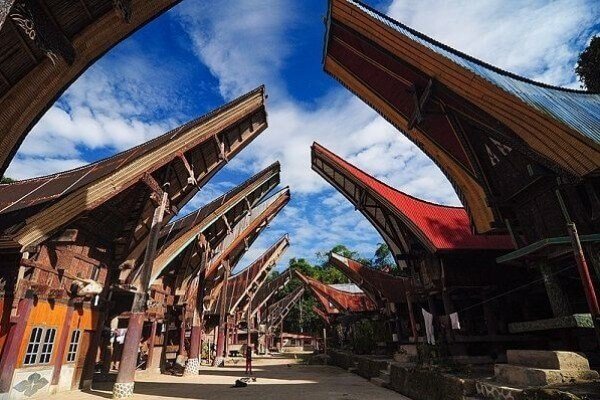Indonesian wooden houses are traditional houses which are commonly found in rural areas of Indonesia. They are known for their unique architectural style, which incorporates elements of local culture and indigenous materials.
These houses are typically built on stilts, to protect against floods and provide ventilation, and often feature high-pitched roofs and large, open verandas. The use of wood as the primary building material gives the houses a natural, organic appearance, and contributes to a sense of warmth and comfort.
The construction of Indonesian wooden houses is a form of folk architecture that reflects the indigenous knowledge and craftsmanship of the local communities. Below a non-exhaustive list of traditional wooden houses:
Rumah Betang : Rumah Betang is a traditional Dayak house from Central Kalimantan, Indonesia, known for its large size and communal living style.
The Rumah Betang is typically a large, multi-tiered structure, with walls made of woven bamboo or wood and a roof made of thatched roofing material. The house is often built on stilts, which provides protection against floods and allows for ventilation.
One of the most distinctive features of the Rumah Betang is its communal living style, with several families living together in a single large house. This reflects the traditional Dayak belief in the importance of community and the interdependence of family members.
The Rumah Betang is also an important cultural symbol, reflecting the Dayak people's rich cultural heritage and beliefs
Rumah Gadang: A traditional Minangkabau house from West Sumatra, known for its grand, multi-tiered roof.
The Rumah Gadang typically features a large, multi-tiered roof, which symbolises the traditional Minangkabau belief in the importance of social status and hospitality. The houses are often large and spacious, with multiple rooms and verandas, and are built on stilts to protect against floods. The walls of the house are typically made of woven bamboo or wood, and the roof is covered in thatched or shingled roofing material.
In addition to serving as a place of dwelling, the Rumah Gadang is also an important cultural symbol, reflecting the identity and history of the Minangkabau people. The houses are often decorated with intricate wooden carvings and painted designs, which serve to tell stories and convey important cultural messages.
Joglo: A Javanese house, characterised by its large, open central hall and high-pitched roof.
The Joglo features a large central room, which is covered by a high-pitched roof made of alang-alang grass or thatched roofing material.
The walls of the house are typically made of woven bamboo or wood, and the central room is surrounded by smaller rooms and verandas. The high-pitched roof provides ample ventilation and natural light, and the large central room is often used as a gathering place for the family or community.
In addition to serving as a place of dwelling, the Joglo is also an important cultural symbol, reflecting the identity and history of the Javanese people. The houses are often decorated with intricate wooden carvings and painted designs, which serve to tell stories and convey important cultural messages.
Rumah Bolon: A bolon house (Batak Toba: Ruma Bolon) is a Northern Sumatra traditional house in Indonesia.
Bolon houses are also tourist objects in Northern Sumatra and are made with wood. The house floor is made with boards while the roof is made with rumbia leaves.
Bolon houses have no individual rooms, but the space inside is divided.There is space for the house leader, for family meetings, for daughters that have married but have no house of their own, and for the oldest son that has already married.
The kitchen is set in the middle of the house. Traditionally, there were several families living in a house. So, they built a kitchen in the middle so they can keep living in harmony and togetherness. There is always a basement. The basement functioned as the place for pig and buffalo.
Rumah Bolon have a unique architecture and interior design. We bow down to enter the house representing the Batak philosophy of respecting the owner of the house which we visit. The back of the house must be built higher than the frontage of the house. This represents another Batak philosophy that a son must be better than his father in everything. So, if someone is a teacher at school, his son has to be a teacher at university.
Every Batak House is also decorated with a Batak painting called "Gorga" Every single touch of the painting has its own meaning. Red, black, brown, and white are the colour combinations used for Batak House. Some of the batak houses are decorated with the head of a buffalo.
Tongkonan: A Toraja house from South Sulawesi, with a distinctive, upward-slanting roof and ornate wooden carvings.
The Tongkonan is typically a large, multi-tiered structure, with walls made of woven bamboo or wood and a roof made of thatched roofing material. The roof slants upwards at the sides, giving the Tongkonan a distinctive, soaring appearance.
The Tongkonan serves as a symbol of the Toraja people's traditional beliefs and cultural values, particularly the importance of ancestor worship and hospitality. The house is also an important gathering place for the community, used for events such as weddings, funerals, and other significant ceremonies.
Rumah Lumbung: A rice barn house, typically found in a few places in Indonesia including Bali, with a distinctive, conical-shaped roof.
The Rumah Lumbung is typically a small, single-story structure, with walls made of woven bamboo or wood and a roof made of thatched roofing material. The cylindrical shape of the house is meant to resemble a traditional grain storage hut, or "lumbung", and symbolises the importance of agricultural abundance and self-sufficiency in Balinese culture.
The thatched roof of the Rumah Lumbung is a significant cultural symbol, representing the traditional Balinese belief in the interconnectedness of all things.












